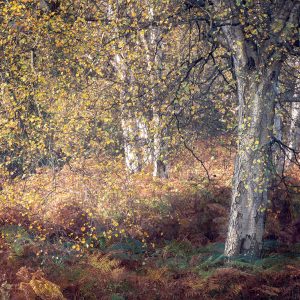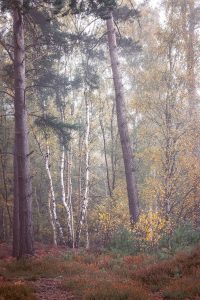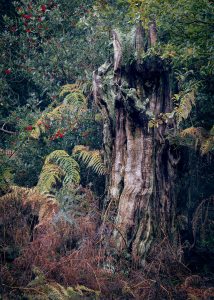Photographing Suffolk’s Woodlands
The Suffolk Coast AONB is made up of a wide range of habitats including some wonderful areas of woodland with vastly differing habitats and characters. These include the rather regimented and uniform pine plantations of Rendlesham, Tunstall and Dunwich Forests, the more diverse mixed woodlands of Captains Wood and Reydon Wood and the fairytale woodland of Staverton Thicks with its vast ancient oaks and hollies.
By their very nature woodlands are chaotic places which can be difficult to photograph, but they are fascinating places to explore and make great subjects for photography.
 Over the past year I have been running a series of workshops which focus on photographing Suffolk’s woodlands. They are centred around Upper Hollesley Common, Rendlesham Forest, Staverton Thicks and Captains Wood. These habitats are all completely different in their characters and provide some wonderfully varied photography with the opportunity to practice a range of creative skills from composition through to multiple exposure and intentional camera movement.
Over the past year I have been running a series of workshops which focus on photographing Suffolk’s woodlands. They are centred around Upper Hollesley Common, Rendlesham Forest, Staverton Thicks and Captains Wood. These habitats are all completely different in their characters and provide some wonderfully varied photography with the opportunity to practice a range of creative skills from composition through to multiple exposure and intentional camera movement.
My workshops usually begin on Upper Hollesley Common because it is the most diverse woodland location with a variety of habitats in close proximity; silver birch glades, areas of beech, pine plantations and open heathland. At first these areas can seem chaotic, full of competing random elements with little discernible order. The key is to try to simplify the scene by focusing on an element that catches your eye and then composing an image around it using supporting elements to add depth and interest.
 In woodland photography what to leave out of the frame can be just as important as choosing what to include. I will usually try to eliminate the sky as this will be the brightest part of the image and can often be distracting. Using a telephoto lens and zooming in to a particular part of the woods can produce really successful images. Try using a shallow depth of field to make your subject stand out from its background. Front to back sharpness is not always necessary in woodland photography and some softness around the subject can be much more attractive.
In woodland photography what to leave out of the frame can be just as important as choosing what to include. I will usually try to eliminate the sky as this will be the brightest part of the image and can often be distracting. Using a telephoto lens and zooming in to a particular part of the woods can produce really successful images. Try using a shallow depth of field to make your subject stand out from its background. Front to back sharpness is not always necessary in woodland photography and some softness around the subject can be much more attractive.
Some of my favourite parts of Upper Hollesley Common are the birch glades near the car park. At first glance finding an image in this area looks like a challenge, the silver birches are scattered randomly amongst pine trees and there doesn’t seem to be any obvious patterns to the planting. When I first arrive at a location I will spend some time walking around and getting a feel for the area before I reach for the camera. A small change of direction can make a massive difference to your chances of finding a successful image. Look for groups of trees or trees that stand out on their own or create a contrast with their surroundings. Look for bold shapes or areas of colours and see how these relate to each other.
 In contrast to the relative order of Upper Hollesley Common, Staverton Thicks is a magical and wonderfully natural fairytale woodland located just beyond the Rendlesham Forest Centre on the Butley Road. It is renowned for its vast oaks and hollies many of which are hundreds of years old. The woodland floor is littered with fallen branches and decaying leaves and at first glance the whole place feels overwhelmingly confused and chaotic. There is no pattern to the planting and the fallen branches on the woodland floor make tidy compositions difficult, but the beauty of this place is its variety and fairytale qualities which make shooting here a real joy as well as a massive challenge
In contrast to the relative order of Upper Hollesley Common, Staverton Thicks is a magical and wonderfully natural fairytale woodland located just beyond the Rendlesham Forest Centre on the Butley Road. It is renowned for its vast oaks and hollies many of which are hundreds of years old. The woodland floor is littered with fallen branches and decaying leaves and at first glance the whole place feels overwhelmingly confused and chaotic. There is no pattern to the planting and the fallen branches on the woodland floor make tidy compositions difficult, but the beauty of this place is its variety and fairytale qualities which make shooting here a real joy as well as a massive challenge
Captains Wood is another area of Suffolk woodland that is worth exploring. It has large areas of beech, silver birch and coppiced hazel groves. It also has some lovely old oak trees and is renowned for its bluebell displays in the spring.
Elements to consider for successful woodland images
Think about composition:
What caught your eye?
What are the relationships between the elements in the scene?
What is your point of view and if you change it will your image be more successful?
Look for bold shapes, contrasting elements and element that stand out from their surroundings.
Think about depth of field and how to use this creatively – front to back sharpness is not always necessary all of the time.
Think about lighting and how you can use this creatively. Shooting into the light can often produce really successful images and will create a dreamy bokeh effect.
Try eliminating the sky from your image. This will be the brightest part of the scene and can often be distracting.
Woodlands can be dark places so take a tripod. A polarising filter is also very useful as this can eliminated unwanted glare from foliage and boost colours.
Think about the weather. Mist is great for atmospheric images and will also help conceal some of the chaos that is present in the forest. Rainy days are some of my favourite times for woodland photography as the water will always boost the colour and mood. Rainy days are particularly successful in the autumn and work wonders on the autumn colour.
Try to avoid harsh light as this will create dark shadows and bright areas which can be a challenge to expose for and will also create an image full of contrast which may obliterate some fo the detail you are seeking to portray.
Most of all have fun and be creative.
To find out more about my woodland workshops please see www.landscapephotographytuition.co.uk or contact me for more details
More of my woodland images can be seen in my woodland portfolio